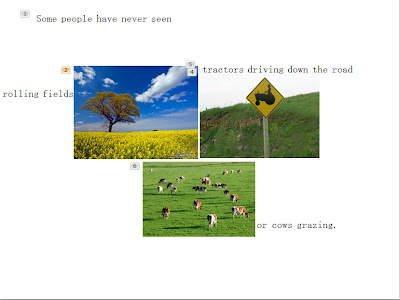



In order to critique e-poetry, it's necessary to have some working knowledge of it and to experience the creation process yourself. This way, you will get a sense of what goes into it. It's just like anything else; you can never truly understand the effort put into something until you've attempted to do it yourself. Let's just say that I now have an immense appreciation for e-poetry and a great respect for the creators. My attempt to create e-poetry was anything but successful. For an hour and a half, I struggled with what to write about, what aspects of e-poetry to include, and learning how to apply those aspects. I don't have much to show for it either.
First of all, I'm not very creative when it comes to writing poetry nor am I very knowledgeable of how to work PowerPoint. I know the basics of putting together a presentation of information for a class but I've never had experience with the special effects so my e-poem was very basic and very literal. My title page was very basic and I wanted to convey a recurring theme of simplicity so everything is in lower case. In my next slide, I only put a few words on it that describe my hometown and I tried to use special effects that exemplified those words. I wanted to show how much I love my town so in my next slide when I referred to it as "a world of treasure" I changed the font to a prettier font to emphasize those words. I struggled with the next slide because I had many different entrances for each text and image and I couldn't figure out how to get them in the right order so that took up a good amount of time. It was definitely fun applying all the special effects but it was much more difficult than I had hoped because there were so many things I had to consider like timing, delay, sequence, duration, and whether it would begin with a click or begin on its own. It was a lot to think about for someone who's not so technologically savvy.
Not much of my e-poem was restricted to a digital version. I had trouble letting go of the "writing a poem" mindset that it really resembled a written poem with pictures that just happened to be on a computer screen. I'm well aware that I'm far from an e-poet, but I was frustrated that I couldn't create the same effect and emotions that I got from the poems we've read in class. It also bothered me that I was unable to inspire much thought with my poem because everything I included was so literal that thought was completely unnecessary. The only things that I was able to make more digital were the ways that I presented the images and the texts that went along with them because the way they entered and their special effects seemed to emphasize how I felt about each description. I could easily have gotten carried away with the special effects to the point where it just wouldn't apply to the meaning of the text if I had spent more time with it. However, I feel that I would be able to create something more thought-provoking if I had hand-written because I would be able to focus more on what the poem was about than trying to figure which elements would best enhance what I was trying to say. From this experience, I give props to the e-poets who have so successfully created electronic literature.















